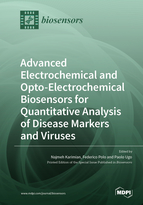Advanced Electrochemical and Opto-Electrochemical Biosensors for Quantitative Analysis of Disease Markers and Viruses
A special issue of Biosensors (ISSN 2079-6374). This special issue belongs to the section "Biosensor and Bioelectronic Devices".
Deadline for manuscript submissions: closed (31 August 2021) | Viewed by 31736
Special Issue Editors
Interests: molecularly imprinted polymers; chemo/biosensors; electrochemical analysis; nanoelectrodes; electropolymerization; nanostructured materials
Special Issues, Collections and Topics in MDPI journals
Interests: molecular electrochemistry; electro/chemical sensing and biosensing technologies; electrogenerated chemiluminescence (ECL) studies and applications in (bio-)sensing; light-emitting devices and imaging; surface chemistry and synthesis, characterization and application of self-assembled systems (SAMs); metal/metal-oxide nanoparticles and metal complexes for (bio-)sensing; catalysis
Interests: molecular electrochemistry; electrochemosensors and biosensors; environmental electroanalysis; nanoelectrodes and bio-nanoelectrochemistry
Special Issues, Collections and Topics in MDPI journals
Special Issue Information
Dear Colleagues,
The recent global health crisis caused by the SARS-CoV-2 pandemic has dramatically highlighted the urgent need for rapid and reliable analytical devices and methods that are capable of carrying out a large number of quantitative analyses, not only in centralized laboratories and core facilities but also on site, at the patients’ bed-side, or at the medical doctor's practice in view of the point-of-care testing (PoCT). Especially for the case of immunological tests, this recent experience has revealed a relevant gap between the classical ELISA (which provides quantitative and reliable responses, although it must be performed in a centralized laboratory by qualified personnel) and strip lateral flow tests (which are suitable for decentralized use, although they provide only qualitative information that is often lacking the required sensitivity and specificity). New analytical devices are therefore highly sought which will fill this gap, combining the capability to provide quantitative analytical responses with fast and user-friendly applicability.
The advantages typical of electrochemical and optical biosensors (low cost and easy transduction) can nowadays be complemented in terms of improved sensitivity by combining electrochemistry (EC) with optical techniques such as electrochemiluminescence (ECL), EC/surface-enhanced Raman spectroscopy (SERS), and EC/surface plasmon resonance (SPR).
The present Special Issue is devoted to exploring new approaches, solutions, and applications in electrochemical, optical and opto-electrochemical biosensors suitable for the quantitative detection of disease markers with focus on frontiers and challenges in immunochemical or genetic analysis and virus detection.
We seek original research papers or critical reviews that address topics including, but not limited to, the following:
- Point-of-care biosensing;
- Electrochemical and opto-electrochemical immunosensors;
- Electrochemical and opto-electrochemical genosensors;
- Diagnostics and biosensing with aptamers and molecularly imprinted polymers;
- Decentralized quantitative analysis of disease markers;
- Electrochemical detection of viruses.
Dr. Najmeh Karimian
Dr. Federico Polo
Prof. Dr. Paolo Ugo
Guest Editors
Manuscript Submission Information
Manuscripts should be submitted online at www.mdpi.com by registering and logging in to this website. Once you are registered, click here to go to the submission form. Manuscripts can be submitted until the deadline. All submissions that pass pre-check are peer-reviewed. Accepted papers will be published continuously in the journal (as soon as accepted) and will be listed together on the special issue website. Research articles, review articles as well as short communications are invited. For planned papers, a title and short abstract (about 100 words) can be sent to the Editorial Office for announcement on this website.
Submitted manuscripts should not have been published previously, nor be under consideration for publication elsewhere (except conference proceedings papers). All manuscripts are thoroughly refereed through a single-blind peer-review process. A guide for authors and other relevant information for submission of manuscripts is available on the Instructions for Authors page. Biosensors is an international peer-reviewed open access monthly journal published by MDPI.
Please visit the Instructions for Authors page before submitting a manuscript. The Article Processing Charge (APC) for publication in this open access journal is 2700 CHF (Swiss Francs). Submitted papers should be well formatted and use good English. Authors may use MDPI's English editing service prior to publication or during author revisions.
Keywords
- decentralized diagnostics
- disease marker
- virus detection
- advanced biosensing platforms
- electrochemical biosensor
- optical biosensors
- electrochemiluminescence
- electrochemical SERS
- electrochemical SPR
- healthcare








